National Moth Week is behind us. We really enjoyed our Malt, Hops and Moths event at Alamo Brewery last weekend–but the fun doesn’t have to stop there. The celebration of those night flying cousins of butterflies, often cast as ugly step sisters in the world of lepidoptery, can take place ANY night of the week. Just wait for darkness, turn on a light, sit back and enjoy the show.
Here’s five moths that we have in Central and South Texas right now. Open your eyes, look, and you will see them.
The Sphinx Moth
Known in its larval form as the much loathed Tomato or Tobacco Horn Worm, this attractive dusk flier also is often called the “hummingbird moth.” Gardeners despise the Manduca sexta’s consumption of their tomato plants, but I suggest setting aside a few seedlings for these voracious caterpillars, who strike a sphinx-like pose when poked, arching their neck and staring blankly at who’s bothering them.
As moths, these impressive striped flyers move during daylight hours, hovering like helicopters to nectar and provide great observation opportunities. They are members of the Sphingidae family.

Tobacco hornworms on Jimsonweed. Photo by Monika Maeckle
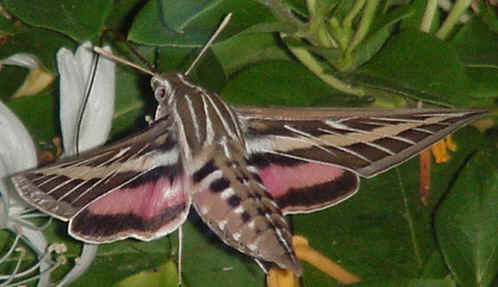
C’mon, admit it: she’s adorable. Sphinx Moth, photo courtesy Colorado State University extension office
Black Witch Moth
Large, bat like and harmless, the intriguing Ascalapha odorata, sometimes known as “the bat moth” resembles a bat in size and shape, and with its seven-inch wingspan is the largest moth in North America. They are common in these parts.
They often hang out near doors and flush when approached, causing quite a startle for the unsuspecting. But remember, they’re completely harmless. Much folklore surrounds their appearance. Throughout the hemisphere, legend has them bringing good luck, a lottery win, or a death in the family, depending on the part of the world and the circumstances of their appearance.
In the movie Silence of the Lambs, serial killer Hannibal Lechter inserted cocoons of Black Witch Moths into the mouths of his victims as a weird gesture of transformation. The moth on the movie poster is a Death’s Head Hawk Moth, but the actual cocoon was that of a Black Witch.
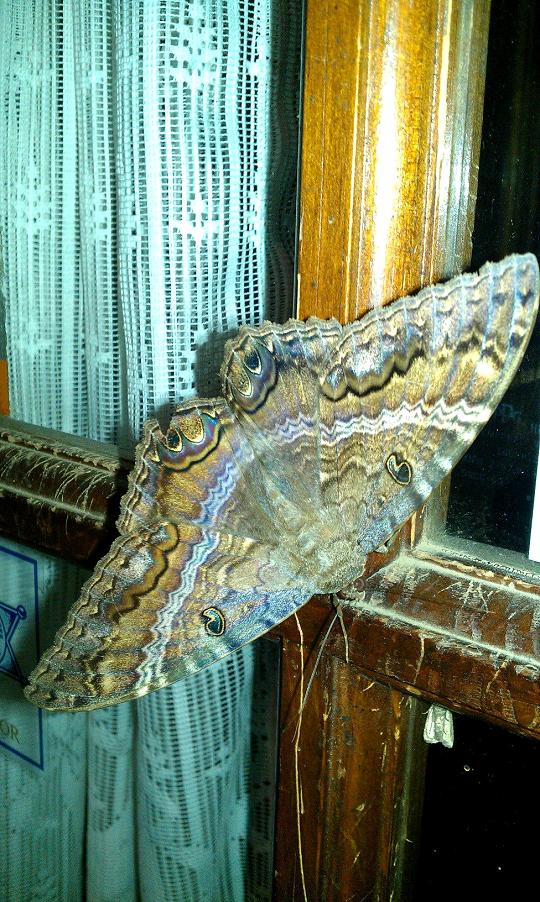
Black Witch Moth photographed by Karen Herrmann in Kansas
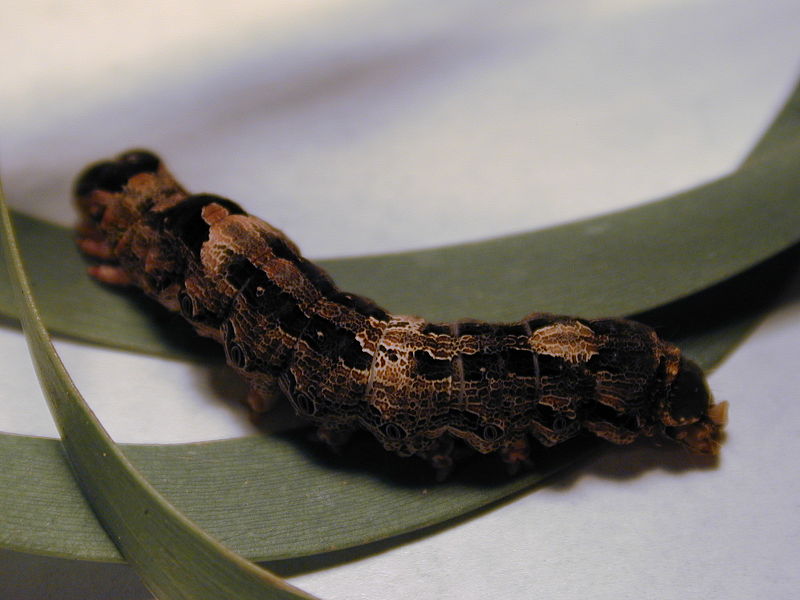
Black Witch Moth caterpillar. Photo via wikipedia.org
Polyphemus Moth
The Polyphemus Moth, Antheraea polyphemus, sports prominent, owl-like eye spots and a six-inch wingspan. The moth is dramatic. We had a hatch of these guys at the ranch one night and several fluttered against the porch spotlights. The sound of their wings hitting the the floodlight was so loud, you would have thought birds or bats had paid a visit.
The Polyphemus gets its name from the Greek myth of the Cyclops Polyphemus (cyclops means one-eyed giant). They’re not unusual and live everywhere in the U.S. and Canada. That they host on a variety of trees–oaks, birches, elms, willows and others–perhaps explains their widespread provenance.
Like many moths, these members of the Saturnid, or silk moth family, spend most of their life as caterpillars, eating up to 86,000 times their body weight at emergence in just two months. Once they become a moth, however, their vestigial mouth parts make eating impossible. Basically, their mouths don’t work any more. Their sole focus as a moth is to reproduce.
Polyphemus change dramatically during the caterpillar cycle and in their final instar become a fantastic three- or four-inch green caterpillar with silver and/or red spots on the side. See the photo below by our friend Mona Milller.
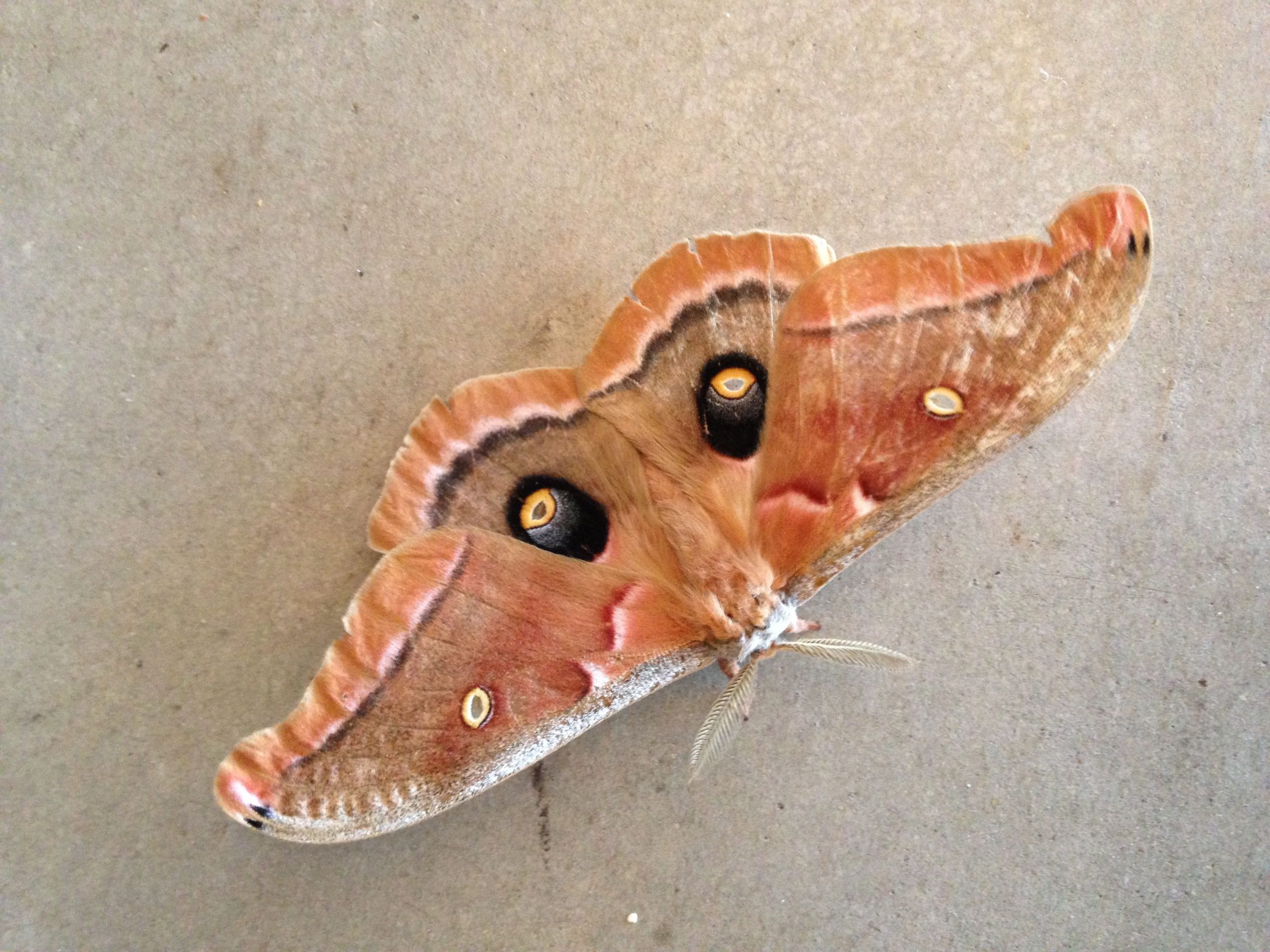
Polyphemus moth. Check out those eyespots! Photo by Monika Maeckle
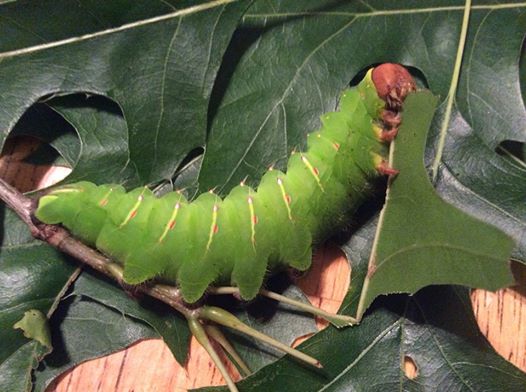
Ailanthus Webworm Moth
The first time I spotted one of these handsome creatures at the ranch I thought it was beetle. They tuck their wings in a tidy fashion, leading you to believe they are of a different genre, but no–they are moths.
Members of the ermine moth family, the small, striped Atteva aua caterpillars build communal nests in the Ailanthus tree by pulling leaves together with webbing and spinning cocoons inside the webs. They are native to Central America, but migrate north in the summer and host on the Ailanthus tree, sometimes called the Tree of Paradise. Both the AWM and the Ailanthus tree are introduced species that have adapted. Non native, but gorgeous creatures.
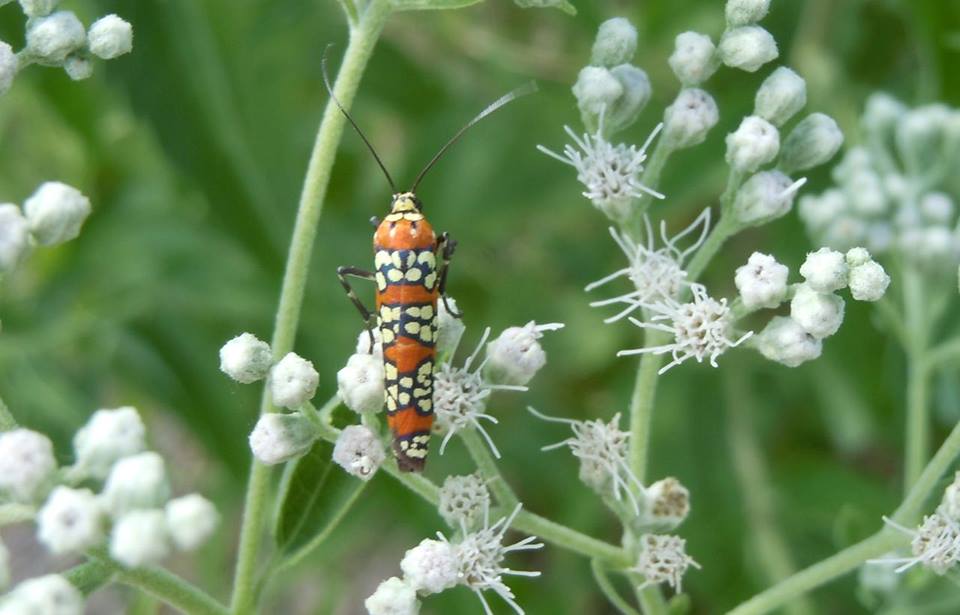
This guy fooled me. Thought he was a beetle, but no, it’s the Ailianthus Webworm Moth. Photo by Monika Maeckle

Luna Moth
This beauty, Actius luna, is one of the most dramatic moths that take to the night. The lime green creatures host on various hardwoods and are apparently found in our area, although I have never seen one.
In their caterpillar stage, Luna Moths are equally impressive, with chubby green body sections punctuated by prominent gold-brown-orange pegs. Like many moths, they only live a week as adults. For that period, they do not eat (they have no mouth parts). Their singular goal is to reproduce.
Good luck hunting moths. Please let us know what you find.

One of the most dramatic moths, the long-tailed glamourous Luna Moth. Photo bu Mike McCafferty, via Wikipedia
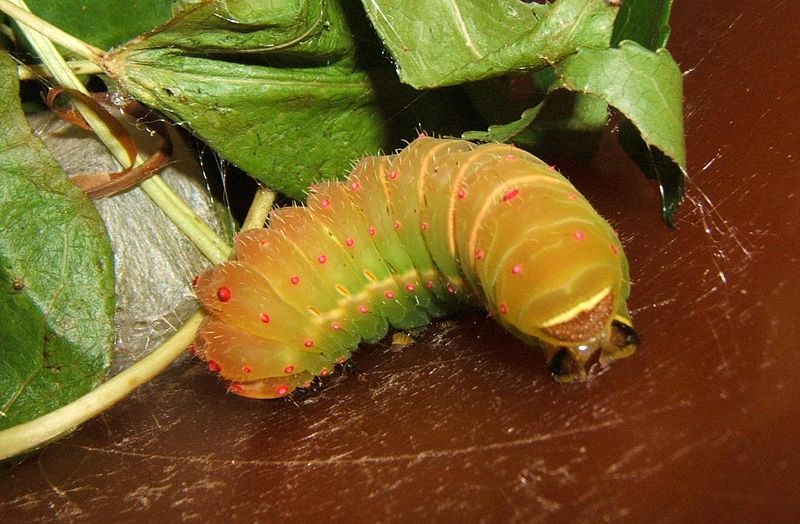
Related Posts
- Moth Night: Lotsa MOTH-ers, Few Moths, $1K raised for FoSANA
- Q&A: Interview with National Spokesmoth Manduca Sexta, Sphinx Moth Says Moths Get No Respect
- Join us for Malt, Hops and Moths: Moth Night at the Alamo Brewery, July 23
- Four Fine Texas Moths for National Moth Week
- Large, Batlike and Harmless: Black Witch Moth Making Appearances in South Texas
- Happy Pollinator Week! Unpaid Workers of Food Web Deserve Respect and Resources
- Genista Moth Caterpillars Return to Llano River Mountain Laurels
- IH 35 to Become Pollinator Corridor for Bees, Monarch Butterflies, Other Pollinators
- Endangered Species Act: Wrong tool for the Job of Monarch butterfly Conservation?
- Tropical milkweed: Ok for Monarch Butterflies, “Just Cut the Dang Stuff Down”
- Wildly Successful: Pollinator Powwow Draws Hundreds from Texas and Beyond
Like what you’re reading? Follow butterfly and native plant news at the Texas Butterfly Ranch. Sign up for email delivery, like us on Facebook, or follow us on Twitter, @monikam.

I’m jealous. We don’t have anything nearly as spectacular in the Northeast. Really gorgeous. Ken
Of course you do, Ken! Check out the Moth Week page on Facebook. Most of the action is up your way. –MM
I found a Luna Moth in my back yard today at first I thought she was dead because she didn’t fly away when I got close or when I touched her a few times she, but at somepoint she started moving but she was badly beaten up,she was missing Antenna,it back left tail wing part was partially gone,I moved her to a safer
spot
Lovely post, Monika. Love all these guys/gals and like you, am still hoping to see a real live Luna moth!
Thanks for this moth-related update, Monika. I enjoy your descriptions of these beautiful critters as much as I do the photos.
Tay
Great post, Monika! We occasionally see Luna Moths in east Texas, as well as Black Witch and Sphinx moths. I’ll keep an eye out for the other species.
Nice web page! I’m a Texas native and moth enthusiast, and have seen about 200 moths, about half in Texas. There are some “special” moths that I have yet to see (Luna, Promethea, Io, Imperial, and a number of Sphinx’s). Butterflies are good, but moths deserve more attention that they get. Anyway, nice to see your page 🙂
[…] Moth from the pool. It was beautiful, with delicate pink flares on it’s wings – click here for a link if you want to know more. Links to the Texas Butterfly […]
I feel pretty fortunate today. I had a Luna by the backdoor of my house in near Friendswood this morning. I’ve lived in the Houston area for about 40 years, and I have never seen one; didn’t even know what it was until I looked it up on the Internet. None of my co-workers, some who have lived in the Houston and Southeast Texas area for than 60 years have ever seen one, either.
You so lucky!
I’d send you a picture, but not sure how; I don’t do Facebook, Twitter, or any of those others but could send it to you some other way (email, text, whatever.) you like. Let me know via the email I listed on my reply.
yes i have seen 2 of them they are in my frount yard i cant wait to see them turn into a beauiful moth they come in my yard every yr i have a tree that seems to like i have been seeing a lot of moths in my neiborhood an we also have all kinds of birds an they are huges its like Africa in southeast Houston
My husband just saw a huge Polyphemus in Katy, TX this evening. It’s wingspan was at least 6 inches. It was underneath a potted plant container. What a treat.
Yesterday there were 4 moths hanging in the tree at our back door. Their “noses” were together to form an X. I took pictures; from the side it looked like 2 but from underneath like 4. In the evening there were 2 with wings spread at the same place. This morn 2/4/19 there were 2 lying on the ground. I picked them up as this is at the steps out of our house; brought them in and they started to wiggle. Put them down and went out came back and one was fluttering around in the bathroom. I don’t know what to do. I made sugar water like humming bird food. put drops on my finger and put them into a large butter fly net house. One that I was holding letting “drink” laid 7 eggs on my finger ; I gathered them in a plastic cup. Now I don’t know what to do. We are to have cold weather for 3 more days. Do I take them out or keep them in . What do I feed them . What to do with the eggs. Help By looking at photos , It looks like black witch moths.
We saw a polythumus moth in our yard this evening.
Found a Luna moth adult drying it’s wings in our backyard. Beautiful!
I just saw a Luna moth for the first time at my house! I live in the Houston metroplex. I took pictures. Beautiful!
It seems we have had the luck of having a Luna moth visit us tonight here in Rowlett, Texas. We were sitting in the backyard by the fire pit when we saw what we thought was a small bat flying around the patio lights. It finally found a spot to hand up under our patio umbrella and after finding this page, we discovered we had the rare fortune of seeing a Luna moth. Probably 4 inch wing span. Beautiful creature. We consider ourselves very lucky.
We used to grow Moonflower vines on our back fence, and they would attract several Luna moths each summer. The plant is similar to a Morning Glory vine, except it has big white blooms that only open at night. Both flowers and moths were beautiful. We thought the moon/luna names were funny, but the moths sure loved those big white flowers. (Far west side of Houston.)
I discovered a Luna Moth Caterpillar on my riding mower cover this morning, 5/24/2020, in Telico, about 10 miles east of Ennis, TX. It looks like a piece of gummy candy.
Hi i saved a dying polyphemus hobbling under my tire. I scooped it up, tried to research what it would drink, it had no interest. It laid eggs right away. They are hatching and dying, i put fresh parsley and kale in there but decided to research what they ate…i came up with oak leaves?
I went out and cut what i think is an oak leaf. Im scouring for any little live caterpillars and am placing them on the leaves along with a light water mist? Can some one verify what they eat?
One site called this moth an Ascalapha Odorata??? It has the four “eye” markings the bigger ones being on the lower wings
Im hoping i can save at least one life for the one that died on my watch 🙏🏽
I love to see so many who share my love of all things in nature.
The Luna moth does not eat in this stage, only as a caterpillar. When it emerges, it lives only to mate and lay eggs.
While mowing today , in Glen Rose, a beautiful butterfly/moth flew by me. I stopped mower and went to bush and took pictures of it, Found your page and ID was the Luna moth! Thanks for the wonderful gift of finding out what it was … beautiful , especially in flight !!!
Can anything be found in Central Texas during March, or is it just too cold?
Hey ya’ll.
I live in Houston, and I just caught a Death Head Hawk moth. It hung out on my back porch for two days. I thought it might be dead. It wasn’t. Is this an invasive species?
Hey Ya’ll.
Me again. I’d like to post a picture of this moth. Not sure how. Anyone?
There was a Black Witch Moth on my front porch light this morning.
We had a luna moth on our Crepe Myrtle tree last summer. Spectacular green and ever since that sighting its my favorite color! We jus saw a glorious Polyfenus moth emerge its silk cocoon in a chickapen oak tree. Wow that big moth came from and inch long coocoon!!! So impressive. Im grateful to have witnessed these creatures Jehovah created for is to enjoy 🙏